Introduction
I must admit, I always enjoy exploring Japan with my wife and our daughter. However, getting around Japan can be quite expensive, especially for budget-conscious travelers. Fortunately, there are several affordable options to explore without breaking the bank.
There are lots of low-cost options to travel to Japan and have fun. You don’t have to spend a fortune to have fun. You can find delicious food and amazing hotels on a budget.
One thing in Japan that is really pricey is the bullet train. So, this brings us to the question – what is the cheapest way to travel in Japan?
In this guide, I will cover the best ways of getting around Japan cheaply, including budget airlines, rail travel, bus services, and cycling. These options ensure you can enjoy your trip without worrying about the cost.
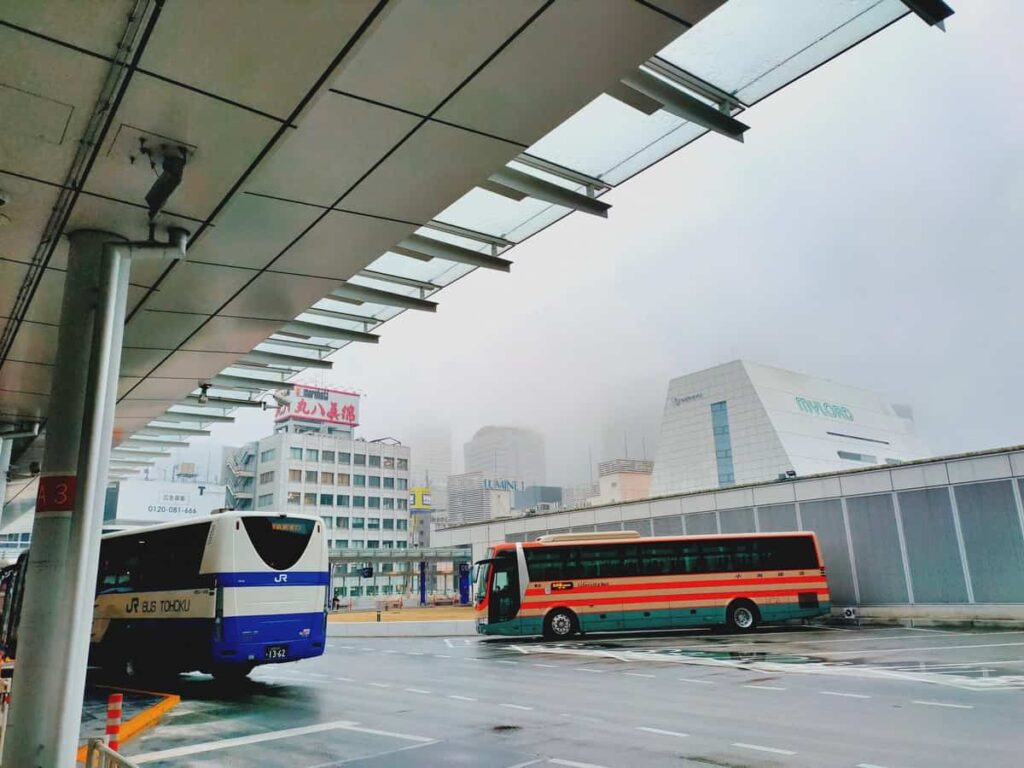
Japan's Transportation System
Travelling around Japan is easy, with an extensive network of trains, buses, and domestic flights connecting major cities and remote areas. However, choosing the right option can significantly impact your travel budget. This brings us to the question – what is the best way to travel around Japan?
Whether you’re looking for the fastest, most comfortable, or the cheapest way to travel, Japan offers a variety of options to suit your needs. From the high-speed Shinkansen trains to budget-friendly buses and domestic flights, there’s a mode of transportation for every type of traveler. Let’s explore these options further to help you make the best decision for your travel plans in Japan.
Getting Around Japan by Plane
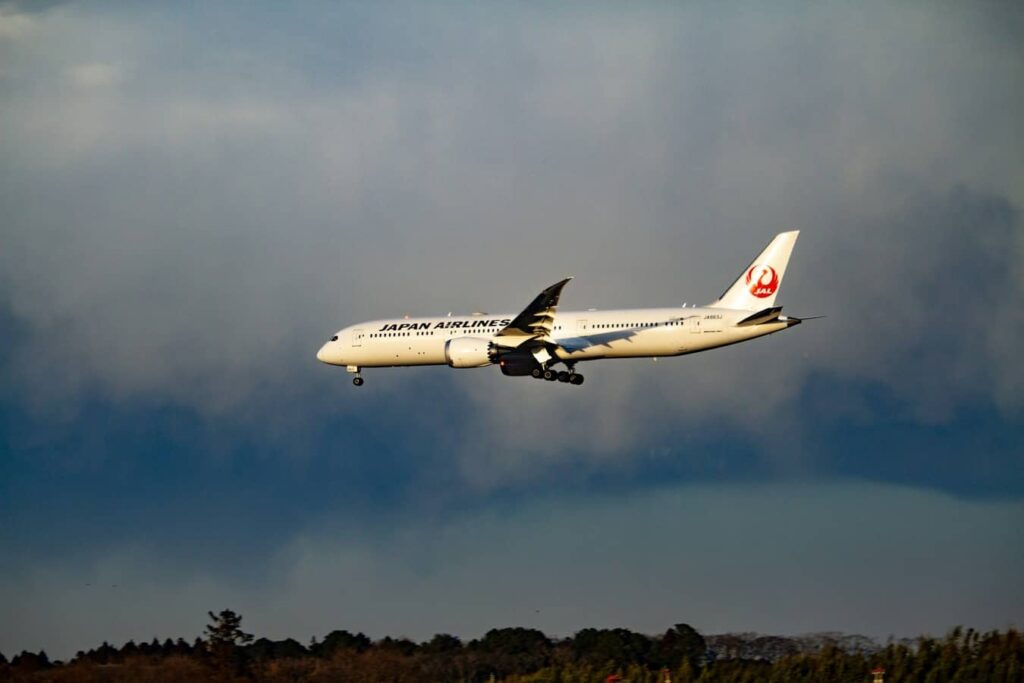
While domestic flights are generally more expensive than other options of transportation, budget airlines like Peach Aviation, Jetstar Japan, and Vanilla Air offer affordable fares, especially for long-distance travel.
Budget Airlines
Peach Aviation:
- Japan’s pioneer low-cost carrier (LCC).
- Known for vibrant orange planes and competitive prices.
Jetstar Japan:
- A joint venture between Japan Airlines (JAL) and Qantas.
- Offers affordable flights with a dash of Aussie flair.
Vanilla Air:
- Budget-friendly flights.
- Check their website for deals.
Tips for Thrifty Flyers
Promotions.
- Keep an eye on their websites and newsletters for flash sales and limited time offers.
- Sign up for fare alerts.
Off-Peak Travel:
- Flying midweek or during off-peak hours often means lower fares.
- Avoid peak holiday seasons like Golden Week or New Year’s if you’re on a tight budget.
Book in Advance:
- Early birds catch the best deals. Secure your tickets well ahead of your travel dates.
Flexible Dates:
- If your schedule allows, play with departure and return dates. Sometimes a day’s difference can save you yen.
Pack Light:
- Budget airlines charge for checked baggage. Travel light with just a carry-on to avoid extra fees.
Why I Still Love Trains and Buses
Japan isn’t huge, I personally prefer taking trains or buses.
Here’s why:
- Scenic Journeys: you can soak in the sights and culture as you go,
- Cost-Efficiency: Trains and buses are often more economical for shorter distances and city hopping.
- Comfort: Buses are usually comfier and more relaxed than flying.
Getting Around Japan by Train Travel
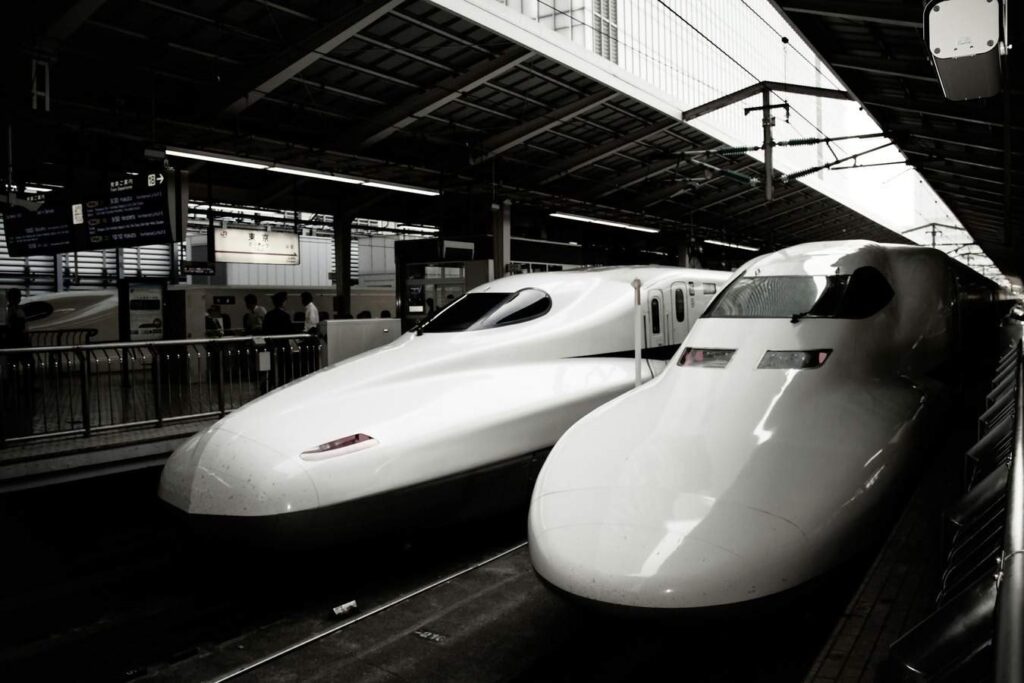
Japan’s rail system is renowned for its efficiency,
The famous Shinkansen (bullet train)
it’s beautiful comfy and fast and super convenient, travelling around at speeds of up to 320 kilometers (200 miles) per hour on their own special tracks.
best way to travel around Japan? Long Distance Yes but it can be very expensive $$.
Riding the bullet train doesn’t come cheap. You could be looking at a hefty price tag of hundreds of dollars for a single ticket sometimes even surpassing the cost of airfare. And that’s not all; on top of the basic fare, there’s an extra “super (limited) express fee” ranging from 800 to 11,000 JPY. Ouch!
There are more budget-friendly alternatives for rail travel. The Japan Rail Pass, available for foreign tourists, offers unlimited travel on JR trains for a fixed price, making it a good option for those planning to cover significant distances.
Additionally, consider purchasing regional passes.
The Japan Rail Pass is a good for budget travelers planning to explore multiple destinations across Japan.This pass grants you unlimited access to all JR trains.
While the upfront cost may seem steep, it can save you a considerable amount of money if you plan to cover long distances.
For shorter trips or travel within a specific region, regional rail passes like the JR East Pass (for eastern Japan), or the Kansai Area Pass (for western Japan) can be more cost-effective. These passes offer unlimited travel within a defined area, making them ideal for city hopping or exploring neighboring prefectures.
If rail passes don’t fit your travel plans, you can purchase individual tickets. Japan’s rail system uses a distance-based fare system, so the cost can vary depending on how far you’re traveling.
How much is Transportation in Japan by train?
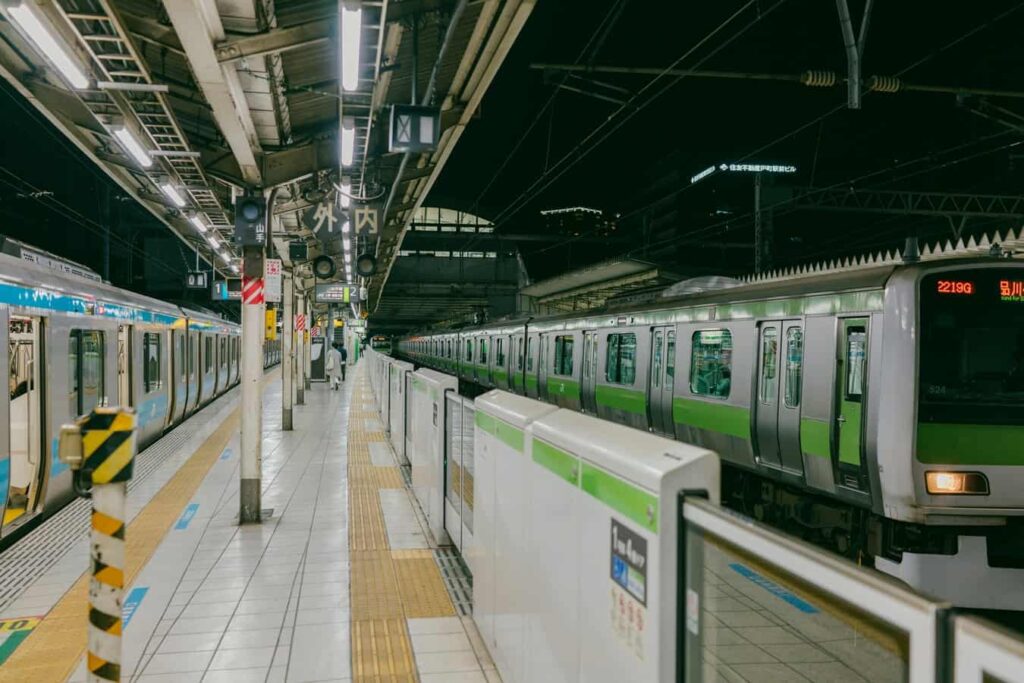
Japan Rail Pass (JR Pass):
- 7-day JR Pass: ¥50,000 for adults, ¥35,000 for children.
- 14-day JR Pass: ¥80,000 for adults, ¥40,000 for children.
- 21-day JR Pass: ¥100,000 for adults, ¥50,000 for children.
- The upfront cost might raise an eyebrow, but trust me—it pays off when you’re covering long distances.
Green Pass (First Class):
- The Green Pass stands for a first-class ticket, granting access to the most comfortable and spacious seating areas on all Shinkansen bullet trains and certain fast lines. What awaits you in the Green Car:
- Wider and softer lazy-boy style seats.
- 40° seat reclining angle.
- Multi-angle footrest.
- Larger legroom & luggage space.
- Extra peace and quiet.
- Larger windows and even a travel magazine.
- The Green Pass is ideal for busy months, especially during cherry blossom season, Golden Week, Obon, and New Year’s Eve.
- It’s like flying first class on land—spacious, plush, and oh-so-comfortable.
- The Green Pass stands for a first-class ticket, granting access to the most comfortable and spacious seating areas on all Shinkansen bullet trains and certain fast lines. What awaits you in the Green Car:
Children’s Discount:
- Kids aged 6 to 11 get a special treat: a child’s pass at half the price of an adult pass.
- Children under 6 ride free but without seat reservations. They can sit on an adult’s lap or in empty seats.
- The diversity of trains across Japan—operated by different JR companies—adds to the adventure. Experience it limitlessly!
Getting Around Japan by Bus Travel
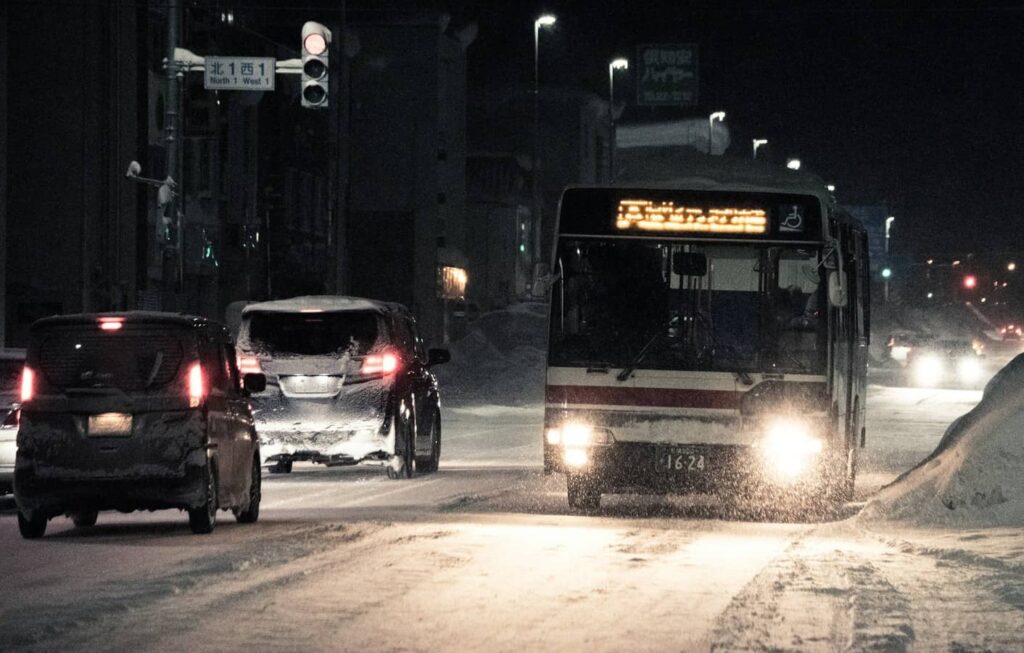
cheapest way to travel in Japan if you’re going a long-distance is the bus, it offers a better way to travel between major cities.
Companies like Willer Express and Japan Bus Lines provide comfortable overnight bus services at a fraction of the cost of trains or flights.
Why Choose Buses?
- Cost-Effective: While the shinkansen (bullet train) may be faster on getting around Japan, buses are significantly cheaper. They allow you to explore Japan without breaking the bank.
- Overnight Travel: Imagine settling into a comfortable seat, drifting off to sleep, and waking up at your destination. Overnight buses make this possible, saving you accommodation costs.
- Flexible Pick-Up and Drop-Off Points: Unlike trains or flights, buses offer a pick-up and drop-off locations. Choose the one closest to you and skip the hassle of getting to a central terminal.
Leading Bus Companies:
Willer Express:
- Known for great deals on overnight buses.
- Japan Bus Pass: Ride to your heart’s content for three, five, or seven days. Non-consecutive days mean flexibility.
- Available to foreign passport holders, including residents.
- Example: Tokyo to Hiroshima round trip for a mere ¥10,000 (on weekdays).
JR Buses:
- Yes, Japan Railways has its own fleet of highway buses.
- Regional companies (JR Kanto, JR Tohoku, etc.) cover the entire country.
Kanto Bus:
- Tokyo-Osaka buses offer private cubicles with flat beds, foldaway tables, and even a powder room.
- Other routes to Kyoto, Nara, and Okayama are more reasonably priced.
Kintetsu Bus:
- Discount services between Kansai and Kanto.
- Osaka or Kyoto to Tokyo for a laughably cheap ¥4,000 one way (mainly on weekdays).
- Ideal for travelers in Kansai heading back to the capital or beyond.
Night Buses vs. Day Buses:
- Night Buses: Depart in the evening, arrive the next morning. Perfect for saving on accommodation costs.
- Day Buses: Travel during the day, arriving later. Choose your favorite type: “day bus” or “overnight bus.”
Cycling and Getting Around Japan

best way to travel around Japan? I actually really enjoy cycling.
Japan’s countryside is breath taking and cycling is an excellent option if living in the cities too.
Most cities are bike friendly, with dedicated cycling paths and rental services.
Cycling allows you to experience the stunning scenery at your own pace while getting some exercise and saving money on transportation.
Cost-Effective Transportation:
- Affordable Rentals: Bike rental services are widely available in cities and tourist areas. You can explore without the burden of owning a bike.
- Minimal Expenses: Once you’ve rented a bike, there are no ongoing costs like fuel or maintenance. It’s a one-time investment for a day of adventure.
No Ticket Fees:
- Unlike trains or buses, you won’t be purchasing tickets for each ride. Your bike becomes your ticket to explore freely.
Sightseeing at Your Own Pace:
- Free Attractions: Japan’s stunning scenery, whether it’s cherry blossoms, rice fields, or coastal views.
Exercise and Health Benefits:
- Fitness Bonus: Cycling doubles as exercise. Pedal through scenic routes while burning calories win-win!
- Healthier Commute: If you’re living in a city, cycling to work or nearby places keeps you active and saves money on public transport.
Catching Ferries & Getting Around Japan

Why Choose Ferries?
Island Connections:
- Japan’s smaller islands, often hidden gems, are accessible only by water.
- Ferries bridge the gaps, connecting these remote paradises.
Three Classes of Comfort:
- Second Class (Without Bed): A budget-friendly option. Common spaces with carpets or tatami mats for resting.
- Second Class (With Bed): Dormitories with 4-12 beds. Ideal for overnight journeys.
- First Class: Rooms with 2-4 beds. A touch of privacy and comfort.
- Special Class: Lavish rooms with about 2 beds, like a cozy hideaway.
Advance Reservations:
- Book your ferry tickets in advance. Some routes require reservations, while others have frequent departures.
- Don’t count on English speaking staff, prepare key phrases.
Ferries & how much is Transportaion in Japan?
Tokyo – Kitakyushu:
- Duration: 34 hours
- Second Class (No Bed): 20,000 JPY
- First Class (With Bed): 23,000 JPY
Osaka – Shibushi:
- Duration: 15 hours
- Second Class (No Bed): 11,000 JPY
- First Class (With Bed): 22,000 JPY
Kobe – Takamatsu:
- Duration: 4 hours
- Second Class: 2,000 JPY (No beds available)
Niigata – Otaru:
- Duration: 16 hours
- Second Class (No Bed): 7,500 JPY
- First Class (With Bed): 16,000 JPY
Kagoshima – Naha:
- Duration: 25 hours
- Second Class (No Bed): 15,000 JPY
- First Class (With Bed): 30,000 JPY
Beppu – Osaka:
- Duration: 12 hours
- Second Class (No Bed): 8,000 JPY
- First Class (With Bed): 24,000 JPY
Do You Need a Car in Japan?

I get this question all the time – Do you need a car in Japan?
Renting a car in Japan might sound good on getting around Japan, but it might not be the best or cheapest way. Renting a car can cost more than taking the bus or train. Also, driving and parking in busy places can be hard. If you don’t know Japanese well, it can be tough to understand road signs. So, I wouldn’t suggest driving a car alone in Japan. It’s better to use public transport. It’s easier and can save you money.
Money-Saving Tips for Using Public Transportation
To make the most of your budget while you’re getting around Japan and finding the best way to travel around Japan consider the following money-saving tips to find the cheapest way to travel in Japan:
- Purchase discounted transportation passes, such as the JR Rail Pass, for long-distance travel.
- Take advantage of early bird discounts or night-time rates for buses and trains.
- Travel during off-peak hours to save on fares.
- Use smartphone apps to find the most cost-effective routes and deals.
- Consider splitting the cost of private transportation (taxis or rental cars) with travel mates.
- Walk or cycle for shorter distances to save money and enjoy the local scenery.
Conclusion
When you’re thinking about getting around Japan, there are a few things to keep in mind. If you want to save money, the cheapest way to travel in Japan is by using public transport like trains and buses. They’re easy to use and get you where you need to go without costing a lot.
But if you’re looking for the best way to travel around Japan, it really depends on what you want. If you want speed and comfort, the bullet train is great. If you’re not in a hurry, buses and local trains can give you a closer look at Japan.
Remember, renting a car might seem like a good idea, but it can be expensive and tricky if you don’t speak Japanese. So, it’s usually better to stick with public transport.
Related Posts
- Dive into luxury with our ultimate guide to the best luxury hotels in Osaka.
- Experience the thrill of Japan’s bustling capital with our post on the top 17 experiences in Tokyo.
- Uncover Historic Kyoto Japan’s Hidden Gems: 20 Must-Sees
- Cherry Blossom in Hokkaido: A Dreamy Island Escape
- Top 5 Anime Stores in Akihabara: Your Ultimate Anime Haven!
